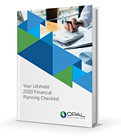Is the 60/40 Portfolio Dead?
By Matthew P. Krouse, AAMS® | March 24, 2021Few things are as important to your investment portfolio as diversification. Just as the name implies, it involves balancing your portfolio with a healthy mix of asset classes. The traditional 60/40 portfolio (60% stocks, 40% bonds) has been the standard benchmark for decades, and with good reason. It’s designed to reduce investment risk over the long term.

The two have a somewhat inverse relationship. Historically, stocks tend to do better when bonds are down, and vice versa. As a result, the 60/40 rule has helped create a shield against market volatility and helps investors recoup losses on both sides. It also helps maximize returns when one isn’t performing well.
But times are changing, and many are wondering if the 60/40 portfolio still makes sense in today’s low-interest rate environment. The answer isn’t so simple. The truth is that there isn’t a one-size-fits-all asset allocation that’s appropriate for each individual investor.
Is Diversification Dead?
Bonds have indeed provided a buffer against stock downturns for decades, which is certainly a good thing. What’s more, 10-year U.S. government bonds have generated average annual returns of about 7% for half a century. Unfortunately, that income-producing power appears to be gradually dwindling when rates are low. Those who purchase this type of bond today can expect a return of just 1.62%. That number was as low as 0.54% in March 2020, when the pandemic was gaining steam.
While bonds have historically helped hedge investment risk when markets decline, they simply aren’t expected to generate enough income to offset future downturns. This can have a direct impact on an investor’s long-term wealth. The picture could be even more grim if we experience a future spike in inflation, which only serves to diminish returns.
Be that as it may, bonds themselves have not become irrelevant. If anything, this type of tumult only drives home the importance of diversification—the more balanced your portfolio is, the better it can withstand unexpected market dips. We’re also likely to see an uptick in market volatility as interest rates rise. Having bonds in the mix can provide liquidity, which can be especially useful when up against stock corrections.
This is all to say that it may be worth revisiting the bond section of your portfolio with your financial advisor.
Why Bonds Are Still Important
Some investors may see the trends around U.S. government bonds and consider going heavier on equities, but there are multiple ways to diversify without taking on so much risk. If your portfolio is tipped unevenly toward stocks, a bout of volatility (and the uncertainty that comes with it) might be too much to stomach. You could also inadvertently set yourself up for huge losses over the long run. This is especially dangerous for folks in retirement who are relying on regular distributions.
Instead, your best bet may be to look into different types of investments to make up for where U.S. government bonds fall short. This could include everything from inflation-protected bonds to floating rate bonds to international bonds. Similarly, alternative investments like real estate, commodities, and master limited partnerships (MLPs) are important to consider in order to increase yields. In the face of a devaluing dollar, dividend-paying stocks and value investing can be attractive strategies, too. Qualified investors can also talk with their financial advisor to see if hedge funds might play a role in reducing risk and adding income.
These strategies can help mitigate risk and may outperform U.S. government bonds over the long haul. Increasing your cash reserves to some degree could also provide more peace of mind, though this should be done with caution, as well. (Stockpiling cash won’t serve you well from an inflation perspective.)
In the End, Every Investor Is Different
When all is said and done, the best investment portfolio is one that’s tailored to your individual short- and long-term financial goals. Just as you change and evolve over time, your portfolio should evolve right along with you to support your vision. Your goals, age and retirement timeline all play a part in figuring out the best asset allocation for wherever you are in this moment. On top of that, periodically rebalancing your portfolio is also recommended. Think of it as an annual portfolio tune-up to make sure that your investments are in line with your goals.
No matter what, the demand for diversification will never go away. Even if the 60/40 portfolio fades away over time, investors will still need to find ways to keep their portfolios fresh, balanced and diverse. This includes investments across different sectors and industries. At Opal Wealth Advisors, we understand that every person is on their own individual journey. Connect with us today to find an investment strategy that works for you.
Be a Smart Investor
Stay up-to-date with industry-leading information and news delivered straight to your inbox.
Get our timely insights delivered to your inbox (Blog)
Please remember that past performance may not be indicative of future results. Different types of investments involve varying degrees of risk, and there can be no assurance that the future performance of any specific investment, investment strategy, or product (including the investments and/or investment strategies recommended or undertaken by Opal Wealth Advisors, LLC [“OWA]), or any non-investment related content, made reference to directly or indirectly in this commentary will be profitable, equal any corresponding indicated historical performance level(s), be suitable for your portfolio or individual situation, or prove successful. Due to various factors, including changing market conditions and/or applicable laws, the content may no longer be reflective of current opinions or positions. Moreover, you should not assume that any discussion or information contained in this commentary serves as the receipt of, or as a substitute for, personalized investment advice from OWA. OWA is neither a law firm, nor a certified public accounting firm, and no portion of the commentary content should be construed as legal or accounting advice. A copy of the OWA’s current written disclosure Brochure discussing our advisory services and fees continues to remain available upon request or at www.opalwealthadvisors.com. Please Remember: If you are a OWA client, please contact OWA, in writing, if there are any changes in your personal/financial situation or investment objectives for the purpose of reviewing/evaluating/revising our previous recommendations and/or services, or if you would like to impose, add, or to modify any reasonable restrictions to our investment advisory services. Unless, and until, you notify us, in writing, to the contrary, we shall continue to provide services as we do currently. Please Also Remember to advise us if you have not been receiving account statements (at least quarterly) from the account custodian.



